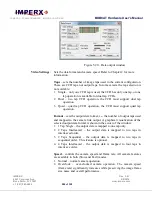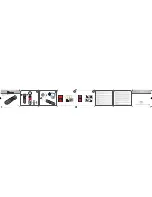
CAMERAS FRAME GRABBERS IMAGING SOLUTIONS
BOBCAT Hardware User’s Manual
IMPERX
Rev. 2.0.7
6421 Congress Ave.
4/8/2014
Boca Raton, FL 33487
www.imperx.com
+1 (561) 989-0006
267 of 329
4.
Computer – the camera expects a signal coming from CC1 or CC2
inputs.
5.
Software – the “Software Trigger” button when pressed starts the
triggering.
Mode
– selects the desired triggering mode:
1.
Standard – in this mode the camera exposes, reads-out the selected
number of frames and waits for the next trigger signal. In this mode
the maximum camera frame rate is LESS than the free-running one.
2.
Fast – in this mode the camera exposes then next frame while
reading the previous. This mode provides the ability to trigger the
camera with its original (free-running) frame rate.
3.
Double – this mode is designed for capture fast processes with short
exposure times, and is commonly used in particle velocity
measurement. It is identical to the Standard mode but, the camera
will capture only 2 frames after each trigger signal. There is no delay
between the frames
4.
Frame Accumulation – in this mode, after each trigger signal the
camera starts integration then transfers the information to the vertical
registers and then waits for the next trigger. After the last trigger has
been received the information is being read out.
5.
Asynchronous – in this mode the camera is free running prior to the
trigger. When the trigger is applied, it resets the CCD timing, flushes
the remaining lines and starts the integration.
Trigger Edge
– the user can select the active triggering edge:
1.
Rising – the rising edge is used for triggering.
2.
Falling – the falling edge is used for triggering.
Trigger Overlap
– the user can select how to handle the next trigger
pulse if arrives while the previous triggering cycle is in process:
1.
Ignore – the next rigger will be ignored, and the camera will
continue its present operation.
2.
Accept – the next trigger will be used.
3.
Accept after Exposure – the next rigger will be ignored while the
camera is exposing the image.
De-bounce
– the trigger inputs are de-bounced to prevent multiple
triggering from ringing triggering pulses. The user has eight choices of
de-bounce interval:
















































